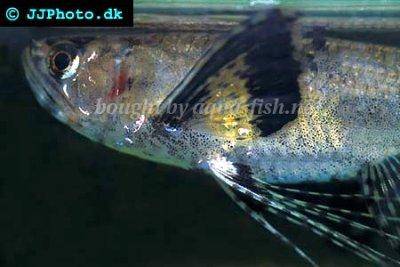African butterfly fish - Pantodon buchholzi
Scientific name: Pantodon buchholzi
Common name: African butterfly fish
Family: Pantodontidae
Usual size in fish tanks: 8 - 10 cm (3.15 - 3.94 inch)
014
Recommended pH range: 6 - 7.5
Recommended water hardness: 2 - 12°N (35.71 - 214.29ppm)
0°C 32°F30°C 86°F
Recommended temperature range: 24 - 30 °C (75.2 - 86°F)
The way how these fish reproduce: Spawning
Where the species comes from: Africa
Temperament to its own species: aggressive/territorial
Temperament toward other fish species: aggressive/territorial
Usual place in the tank: Top levels
General Information
African Butterfly Fish (Pantodon buchholzi) is a classic surface-dwelling predator from slow, vegetated waters of West and Central Africa (Niger, Congo, Ogooué, Lake Chad basin). Adults reach ~10–12 cm TL. With enlarged pectoral fins and an upturned mouth, it specializes in taking prey at the surface and is an expert jumper/glider—a tight-fitting lid is non-negotiable.
Food & Feeding
Primarily a surface insectivore/piscivore. Offer floating foods: live or frozen insects (small crickets, fruit flies, mosquito larvae), floating krill/shrimp, and high-quality floating carnivore pellets. It may ignore sinking foods. Feed once or twice daily in modest portions to avoid fouling calm surface water.
Sexing
Males have a modified anal fin with elongated rays forming a tube-like structure used during spawning; females have a rounder, unmodified anal fin and a fuller body when gravid.
Breeding
Pair in a quiet, shallow tank with dense floating plants and very gentle surface movement. Condition with live foods. Spawning yields floating, adhesive eggs among plants; remove adults or eggs to prevent predation. Incubation is typically ~36–48 h (temperature-dependent). Fry stay at the surface and require tiny live foods that float (infusoria, rotifers; later newly hatched brine shrimp delivered at the surface).
Lifespan
Commonly 5–8 years with stable, warm water and suitable diet.
Tank Requirements & Water Parameters
- Tank size: footprint from 90 cm (36″) length; shallow fill level and large surface area help.
- Temperature: 24–30 °C (75–86 °F); aim mid-upper 20s for long-term health.
- pH: 6.0–7.5; Hardness: soft to moderate (≈ 2–12 °dH). Stability is more important than the exact number.
- Filtration/flow: very gentle surface movement—avoid strong currents that disrupt feeding.
- Aquascape & light: floating plants, dim lighting, dark background; keep surface clear of obstructions for “gliding”.
- Cover: escape-proof lid with no gaps.
- Maintenance: weekly water changes; avoid abrupt parameter swings.
Compatibility & Tank Mates
Predatory and territorial at the surface. Do not keep with small top-dwelling fish that can be swallowed. Suitable companions are mid-/bottom dwellers of similar or larger size (e.g., peaceful larger tetras, rainbows, robust catfish) that ignore the surface. Avoid fin-nippers and boisterous species. Multiple butterflies can be kept only in large, well-covered tanks with heavy floating cover—expect sparring.
Behaviour & Usual Place in the Tank
Strictly a top-level ambush feeder. Spends most time under floating cover, dashing sideways to seize prey. Sensitive to reflections and sudden movement above the tank.
Short Description
Pantodon buchholzi is a distinctive surface predator. Keep it in a calm, covered aquarium with floating plants and offer floating, meaty foods. Choose mid-/bottom-level tank mates too large to be considered prey.
⚠️ Important Care Warnings
- Escape risk: African Butterfly Fish are powerful jumpers—use a tight-fitting, gap-free lid at all times.
- Predatory at the surface: do not keep with small top-dwellers (they may be eaten). Choose mid-/bottom-level tank mates too large to be considered prey.
- Feeding: prefers floating, meaty foods (insects, shrimp). May ignore sinking foods.
- Flow: keep very gentle surface movement; strong currents disrupt feeding and cause stress.
- Cover: provide floating plants for shade and security to reduce skittish behavior.
Pictures
Bought by aqua-fish.net from jjphoto.dk.



